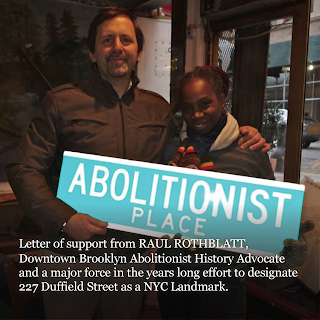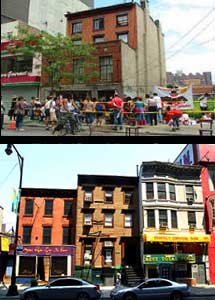AKRF’s Attempt to Demolish Abolitionist Homes Reveals Vast Brooklyn Network
of Resistance to Slavery
Brooklyn, May 2, 2007— There is a firm called AKRF which has 25 years experience in researching big development projects. They recently undertook their longest venture in historical analysis: Two and a half years devoted to trying to deny the claims that Duffield Street in Downtown Brooklyn was part of the Underground Railroad of the Civil War era. Instead, they suceeded in providing the best documentation that the Duffield Street homes are the most promising area for Underground Railroad research in New York City.
The New York City Council Landmarks Subcommittee held an evidentiary hearing on May 1, 2007, chaired by Leroy Comrie. The day started at 10 am. City Council Member Charles Barron held a press conference before the hearing, and he was the first to denounce the findings, but almost every City Council representative present had harsh questions for the NYC Economic Development Corporation and their hired gun, AKRF.
The hearing, which lasted from 11 am to 3 pm at City Hall, began with AKRF Vice President Linh Do’s extended PowerPoint presentation- basically a shortened version of the Executive Summary of their report found at the EDC’s website. In advance of the meeting, the NY Daily News dutifully reported the AKRF talking points: “There's no proof that seven downtown Brooklyn rowhouses were part of the historic Underground Railroad, city officials are expected to tell lawmakers today.”
Barron, in true form, railed against the methodology and the findings. Though he left the hearing before 1 pm, and it turned out that pretty much all nine of the lawmakers had pointed questions for the EDC and AKRF.
Despite AKRF’s talking points, the document itself provided much evidence of Abolitionist activity. AKRF did its best to show that none of this resistance to slavery could be verifiably linked to Duffield Street, but even their Executive Summary (page S-19) admits:
“It is important to note, however, that while a good faith research effort has been conducted to learn as much as possible about the subject properties and their potential Underground Railroad associations, the nature of this type of research means that more information could be unearthed in the future.”
In other words, AKRF can’t deny the possibility of history at these homes. And the City Council members treated to take this possibility seriously.
AKRF's map of Abolitionist Churches in Downtown Brooklyn
I knew that AKRF was in trouble when Councilmember John Liu asked a surprising question: Why was AKRF’s name left off the report? Do (whose name was mangled by almost everyone) answered that it was an oversight, that the full report did include their name, but the PowerPoint handout did not. Liu is not known as a friend of preservationists, but this was part of a line of questioning that focused on the role of AKRF. AKRF seems to want their words to emanate as if from an omnipotent but invisible force of nature.
Through it all, Do was very much on the hot seat, and she seemed exasperated by the line of questioning. The Council Members asked how much AKRF had been paid; the answer given was $500,000 for 3,000 person-hours of research.
Do’s initial presentation offered no surprises, yet it raised many more questions than it answered. Council Member Letitia James hammered on the question of who exactly wrote the report and the role of the peer reviewers. The AKRF document went to great pains to include the CVs of all the historians hired as peer reviewers. James, who was the only lawmaker who seemed to have read the entire 700-page document, tore into Do because many of the peer reviewers completely disagreed with the conclusion that there was no historical proof for Underground Railroad activity on Duffield Street. Their comments were buried in Appendix C of the published report.
James added some color when she said that there’s a Nigerian saying that “don’t let the lions tell the giraffe’s story,” referring to the developers trying to tell the story of those who resisted the legal institution of slavery. But colorful language was not necessary, because nobody besides AKRF and the EDC seemed in favor of the demolition of these homes. Councilmember Rosie Mendez summed it up this way when speaking to Do: “I hear you saying ‘we believe’ and ‘we think,’ but after a half million dollars, I’d want better proof. It sounds like you’re trying to avoid a lawsuit.”
AKRF certainly tries to defend its credibility. A journal called Village Views describes AKRF’s contentious record this way (Volume X, #1 p.5):
According to the Brooklyn Papers, at the City Council subcommittee hearing on the adoption of the Downtown Brooklyn Plan, June 14, 2004, an Economic Development Corporation executive claimed that “a dozen agencies” including the Schomburg Center for Research on Black Culture of the New York Public Library had been consulted by AKRF when they made these determinations.
But Christopher Moore, exhibition coordinator for the Schomburg Center, testified that nobody from the city had ever contacted his organization regarding Duffield Street. “I have never spoken to any representative of your firm about the possibility or probability of Underground Railroad activity on or near Duffield Street,” said Moore, who is also a city Landmarks Preservation Commissioner. “Had any representative of your firm actually spoke to me, I would have informed them, without hesitation, that the entire length of Duffield Street is one of the city’s most promising areas for the study of Underground Railroad activity.”
But at the hearing, Do stated that they never mischaracterized Moore and that he had written a letter saying this was all a misunderstanding. But this was typical of AKRF’s plausible deniability. Do didn’t state that Moore proclaimed Duffield Street’s importance. And Do also failed to convince anyone, since several people at the hearing had heard Moore’s 2004 testimony, and those who knew Moore doubted the implication that he was just some forgetful fellow.
The Council Members reacted with disbelief when the EDC said that they didn’t hire archeologists to examine the site because that would require demolishing the buildings. When asked if they had hired any archeologists, the EDC responded that they had hired an architectural historian. When asked again by both Barron and Liu why they didn’t hire an archeologist, the EDC again responded that they had hired an architectural historian. This line of questioning continued, and eventually the EDC defended their actions by stating that hiring an archeologist would require the demolition of the buildings being studied. This brought incredulous reactions from all of the council members. (Much later in the hearing, the council members were very curious about one of the peer reviewers who had brought nine (9) archeologists to examine the site. Nobody seemed to mention that 229 Duffield is an empty lot, and archeological work would be easy there without demolishing anything.)
Do began to wilt under the heavy questioning. But the EDC continued to claim that the destruction of these properties was essential to the redevelopment of Brooklyn. Liu tried to get a straight answer of how important for the redevelopment plan it would be to build a parking lot including the Duffield Street houses.
The EDC (sorry, I didn’t catch the representative’s name) claimed that the “City does recognize Abolitionist activity in the neighborhood and wants to memorialize it,” but that the parking and open space that would be build on what is now the Duffield Street homes was a “major resource” of their plan. If was saved from demolition, “It would have a major impact on the plan. Without this space, it will be difficult to create office space.”
Liu was incredulous. He asked, “what if AKRF said there was a significant amount of linkage [to the Underground Railroad], would the entire Brooklyn plan be thrown out?” The EDC had difficulty answering.
Eventually, Do and the EDC representatives left. Unfortunately, as one might hope for a company charged with researching this sensitive site, they did not bother to stick around to hear the additional two hours of testimony by historians, residents, ministers, and assorted Brooklynites.
The most damning testimony came from the peer reviewers hired by AKRF. They gave a sense of how the AKRF document was created. It should be noted, that these eminent historians were hired as peer reviewers, not as researchers who wrote the document. The actual authors remained behind a dark veil of anonymity. The consensus of the historians who worked on the project was that “the AKRF researchers displayed a remarkable ignorance.” They chided AKRF for having “no research plan and no basic methodology.”
Bob Furman, a noted Brooklyn historian and preservationist who was not one of the peer reviewers, gave one example of the AKRF researchers’ lack of basic Abolitionist knowledge. At one point, AKRF wrote that the Brooklyn Eagle was founded by Lewis Tappan. The reason that this is an embarrassing mistake is the paper’s original name was “Brooklyn Eagle and Kings County Democrat”- it was a partisan Democratic Party publication, and the Democrats essentially supported slavery while Tappan was one of the most influential abolitionists in Antebellum America. A first year history student would have caught that mistake.
One of the three peer reviewers Dr. Cheryl LaRoche was happy with the research conducted by AKRF. She thought it was a promising beginning for research into the area. For a consulting firm like AKRF, working 2 1/2 years on a research project is an eternity. For a serious historian like LaRoche, this is just the warm up. Many historical research projects take 10 or even 20 years. While AKRF tried to spin their findings as showing lack of significant proof on Underground Railroad activity, LaRoche came to the opposite conclusion. She has studied Underground Railroad history all around the country, and regarding Duffield she said “You do have an Underground Railroad site here. This is a phenomenal site.”
By the end of the hearing, at 3 pm, the only City Council representatives left were Comrie, Yassky, and James. Not one person spoke in favor of demolishing the Duffield Street homes.
LaRoche’s words seemed to give the end of the hearing a sense of victory. Through AKRF’s attempt to whitewash the Abolitionist history, they had clearly proven to everyone present that Duffield Street is probably THE most important site for Underground Railroad activity in New York City. AKRF’s strongest claim is that there is no documentable proof that these properties were part of the Underground Railroad, but for those who stayed, we were left with the clear impression that these are probably the best documented sites that we have. As a few council members pointed out, many buildings have been landmarked with much less documentation.
I left the hearing tired, but optimistic. We WILL save this history. I clearly see the day that the Duffield Street homes will be part of a vibrant Downtown Brooklyn, and destination for those who want to discover the proud history of our Abolitionist history.
Stay tuned for more updates. The hearing on eminent domain will probably happen later this month.












